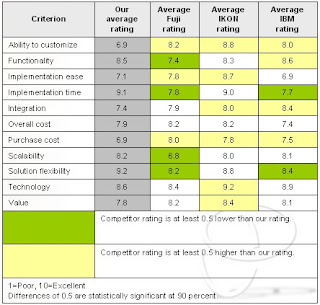Using Win Loss to Produce Tactical Competitive Intelligence
During our most recent webinar (hosted on 10/25/2007 and available for download here ), Ron Sathoff and I talked about three of the biggest benefits of Win Loss. One of those points was the level of actionable competitive intelligence that is available through debriefs of your recent sales prospects.
At Primary Intelligence, we emphasize competitive intelligence that will help your sales, marketing and business development organizations create more revenue, strengthen competitive positioning and refine value propositions to be more effective than your competitors.
How do we do this? Primarily, we use Win Loss studies to measure competitive performance during some of the most valuable times; namely, when your company, product and sales performance are being compared with your direct competitors.
Some examples of this type of reporting and analysis include:
Competitive landscape analysis: The chart above shows the frequency of encounters with specific competitors. In many cases, we’ll identify changing trends in the major players in different industries. We help show when the boutiques and upstarts are gaining traction. We’ll show the competitors that fight the hardest and those that fall by the wayside when you are in the opportunity. Of course, all of these findings can be filtered by vertical, company size, etc…
The chart above shows the frequency of encounters with specific competitors. In many cases, we’ll identify changing trends in the major players in different industries. We help show when the boutiques and upstarts are gaining traction. We’ll show the competitors that fight the hardest and those that fall by the wayside when you are in the opportunity. Of course, all of these findings can be filtered by vertical, company size, etc…
Competitive Performance Analysis
To increase your effectiveness and win more business, you have to know where you compare on key decision-making criteria versus you strongest competitors. Your prospects watched you perform and compared your capabilities with other companies in the deals. Over time, your strengths rise to the top while your weaknesses become very apparent.
With this type of intelligence, you can pinpoint today’s strengths and tomorrow’s improvements. Make sure that you are able to address perceived areas of deficiencies before the competition can exploit them.
Not only will this information help you sell more effectively, but you can keep tabs on the competition. Over time, you can watch where their strengths and weakness scores move. You can infer the areas that the competition has targeted for improvement and move to counter their gains.
SWOT Tables, Illustrated with Examples
Finally, let’s make the Strengths and Weaknesses section of the SWOT mean something. Direct quotes from your prospects explaining specific strengths and weaknesses put teeth into your recommendations. Sales people usually like this stuff the best because they can read a few sentences and use that information right away.
Boy. Today’s post has really come across as a commercial… more so than usual. But, that’s the way things go some days.. even in Australia. (Gold stars for anyone that posts or replies to me with the source of the “even in Australia” comment.)


No comments:
Post a Comment